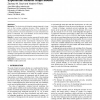Free Online Productivity Tools
i2Speak
i2Symbol
i2OCR
iTex2Img
iWeb2Print
iWeb2Shot
i2Type
iPdf2Split
iPdf2Merge
i2Bopomofo
i2Arabic
i2Style
i2Image
i2PDF
iLatex2Rtf
Sci2ools
BIOINFORMATICS
2007
2007
Exploring biological network structure using exponential random graph models
Motivation: The functioning of biological networks depends in large part on their complex underlying structure. When studying their systemic nature many modeling approaches focus on identifying simple, but prominent, structural components, as such components are easier to understand, and, once identified, can be used as building blocks to succinctly describe the network. Results: In recent social network studies exponential random graph models have been used extensively to model global social network structure as a function of their “local features.” Starting from those studies, we describe the exponential random graph models and demonstrate their utility in modeling the architecture of biological networks as a function of the prominence of local features. We argue that the flexibility, in terms of the number of available local feature choices, and scalability, in terms of the network sizes, make this approach ideal for statistical modeling of biological networks. We illustrate ...
| Added | 08 Dec 2010 |
| Updated | 08 Dec 2010 |
| Type | Journal |
| Year | 2007 |
| Where | BIOINFORMATICS |
| Authors | Zachary M. Saul, Vladimir Filkov |
Comments (0)

